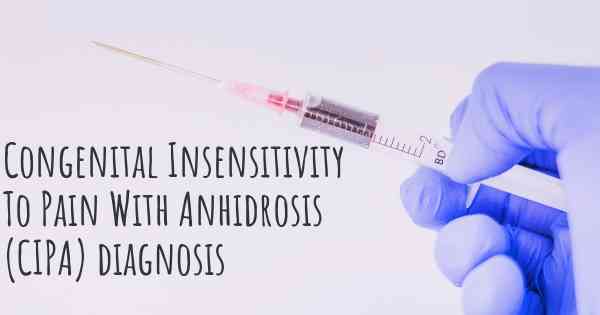How is Congenital Insensitivity To Pain With Anhidrosis (CIPA) diagnosed?
See how Congenital Insensitivity To Pain With Anhidrosis (CIPA) is diagnosed. Which specialists are essential to meet, what tests are needed and other useful information for the diagnosis of Congenital Insensitivity To Pain With Anhidrosis (CIPA)

Congenital Insensitivity To Pain With Anhidrosis (CIPA), also known as hereditary sensory and autonomic neuropathy type IV (HSAN IV), is a rare genetic disorder characterized by the inability to feel pain and the inability to sweat. It is a result of mutations in the NTRK1 gene, which is responsible for producing a protein called tropomyosin receptor kinase A (TrkA). TrkA is essential for the development and survival of nerve cells that transmit pain, temperature, and touch sensations.
Diagnosing CIPA can be challenging due to its rarity and the variability of symptoms among affected individuals. However, there are several key steps involved in the diagnostic process:
1. Clinical Evaluation: The first step in diagnosing CIPA is a thorough clinical evaluation by a healthcare professional. They will review the patient's medical history, including any reported symptoms and family history of similar conditions. The healthcare professional will also conduct a physical examination to assess the patient's ability to feel pain, sweat, and detect any other associated symptoms.
2. Genetic Testing: Genetic testing plays a crucial role in confirming the diagnosis of CIPA. A blood or saliva sample is collected from the patient, and DNA sequencing techniques are used to identify mutations in the NTRK1 gene. Genetic testing can help differentiate CIPA from other conditions with similar symptoms.
3. Nerve Biopsy: In some cases, a nerve biopsy may be performed to further support the diagnosis of CIPA. During a nerve biopsy, a small piece of nerve tissue is surgically removed and examined under a microscope. The biopsy can reveal abnormalities in the nerve fibers, such as a reduced number of nerve endings or abnormal nerve structure.
4. Sweat Test: An important characteristic of CIPA is the inability to sweat (anhidrosis). A sweat test, also known as a thermoregulatory sweat test, can be conducted to assess the patient's sweat production. This test involves applying a powder that changes color when exposed to sweat to the patient's skin. The patient is then exposed to heat or exercise to stimulate sweating. The absence of sweat production confirms the presence of anhidrosis, a hallmark feature of CIPA.
5. Electromyography (EMG) and Nerve Conduction Studies: EMG and nerve conduction studies may be performed to evaluate the function of the peripheral nerves. These tests involve the insertion of small electrodes into the muscles or the application of electrodes on the skin to measure electrical activity. Abnormal results can indicate peripheral nerve damage or dysfunction, supporting the diagnosis of CIPA.
It is important to note that the diagnosis of CIPA requires a multidisciplinary approach involving geneticists, neurologists, and other specialists. Additionally, the diagnosis may be confirmed through a combination of the above-mentioned tests, depending on the individual case.








